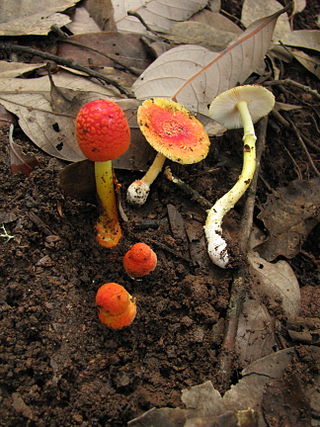
Amanita phalloides, commonly known as the death cap, is a deadly poisonous basidiomycete fungus, one of many in the genus Amanita. Widely distributed across Europe, but introduced to other parts of the world since the late twentieth century, A. phalloides forms ectomycorrhizas with various broadleaved trees. In some cases, the death cap has been introduced to new regions with the cultivation of non-native species of oak, chestnut, and pine. The large fruiting bodies (mushrooms) appear in summer and autumn; the caps are generally greenish in colour with a white stipe and gills. The cap colour is variable, including white forms, and is thus not a reliable identifier.

The genus Amanita contains about 600 species of agarics, including some of the most toxic known mushrooms found worldwide, as well as some well-regarded edible species. The genus is responsible for approximately 95% of fatalities resulting from mushroom poisoning, with the death cap accounting for about 50% on its own. The most potent toxin present in these mushrooms is α-Amanitin.
Amatoxin is the collective name of a subgroup of at least nine related toxic compounds found in three genera of poisonous mushrooms and one species of the genus Pholiotina. Amatoxins are very potent, as little as half a mushroom cap can cause severe liver injury if swallowed.

Amanita cokeri, commonly known as Coker's amanita and solitary lepidella, is a poisonous mushroom in the family Amanitaceae. First described as Lepidella cokeri in 1928, it was transferred to the genus Amanita in 1940.

Amanita ocreata, commonly known as the death angel, destroying angel, angel of death or more precisely western North American destroying angel, is a deadly poisonous basidiomycete fungus, one of many in the genus Amanita. The large fruiting bodies generally appear in spring; the cap may be white or ochre and often develops a brownish centre, while the stipe, ring, gill and volva are all white. A. ocreata resembles several edible species commonly consumed by humans, increasing the risk of accidental poisoning. Mature fruiting bodies can be confused with the edible A. velosa, A. lanei or Volvopluteus gloiocephalus, while immature specimens may be difficult to distinguish from edible Agaricus mushrooms or puffballs.

Amanita subjunquillea, also known as the East Asian death cap is a mushroom of the large genus Amanita, which occurs in East and Southeast Asia. Potentially deadly if ingested, it is closely related to the death cap A. phalloides.

The European white egg, bearded amanita or European egg amidella, is a species of fungus of the genus Amanita in the family Amanitaceae. It is a large, white-colored fungus, often tinged with cream. Native to Europe, it is found on plains as well as mountains in the Mediterranean region. It is similar to some deadly poisonous species.

Amanita smithiana, also known as Smith's amanita, is a species of agaric found on soil in coniferous and broadleaved woodland in the Pacific Northwest of North America. It fruits in August and September.

Amanita echinocephala is a large, whitish or ivory-coloured mushroom with a characteristic spiny, or warty-looking cap. A. solitaria is a synonym and opinions are divided as to which name takes precedence. It lives on chalky soils with beech trees, and appears earlier than most mushrooms of similar size in southern England. It frequently occurs singly or in small groups, resulting in it being referred to as the solitary amanita or, more specifically, European solitary lepidella. It is very drought-tolerant.

Amanita franchetii, also known as the yellow veiled amanita, or Franchet's amanita, is a species of fungus in the family Amanitaceae.

Amanita rubrovolvata, commonly known as the red volva amanita, is a species of fungus in the family Amanitaceae. The fungus produces small to medium-sized mushrooms, with reddish-orange caps up to 6.5 millimetres wide. The stems are up to 10 cm (4 in) tall, cream-coloured above the ring and cream to yellowish below it. The stem ends in a roughly spherical bulb at the base, which is covered with bright orange patches.

Amanita pseudoporphyria, also known as Hongo's false death cap, is a species of agaric fungus from the genus Amanita.

Amanita fuliginea, commonly known as the east Asian brown death cap, is a species of deadly poisonous mushroom in the family Amanitaceae. The fruit bodies have convex, dark gray to blackish caps measuring 3–6 cm (1.2–2.4 in) in diameter. The gills, largely free from attachment to the stipe, are white and have short gills (lamellulae) interspersed. The spores are roughly spherical, amyloid, and typically measure 8–11 by 7–9.5 µm. The species was described as new to science by Japanese mycologist Tsuguo Hongo in 1953. A. fuliginea is classified in Amanita section Phalloideae, which contains the infamous destroying angel.

Amanita caesareoides is a species of Amanita from China, Korea, and Japan.

Amanita chlorinosma, also known as the chlorine lepidella or chlorine Amanita, is a North American species of Amanita. Its life cycle is perennial. It is easily distinguished by its strong unpleasant odor.
Amanita pallidorosea is a deadly poisonous mushroom of the large genus Amanita, closely related to A. bisporiga. It occurs in China under beech trees.

Amanita flavipes is a species of Amanita found in oak and conifer forest of China, India, Japan, Pakistan, and South Korea.
Amanita rimosa is a species of agaric fungus in the family Amanitaceae native to Hunan, first described by P. Zhang & Zhu L. Yang in 2010. Like other Phalloideae amanitas, it is lethally toxic. A distinctive feature of A. rimosa is its rimose pileus, caused by slightly gelatinized upper layer of the pileipellis, which is a rare structure among other Amanita species.
















